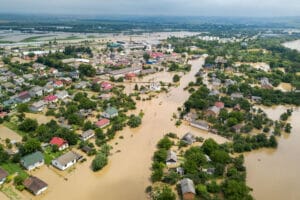Maximizing safety for students and employees
If you’re anything like me, keeping your family safe is your number one priority. During the Covid-19 pandemic, this means minimizing social contact to reduce the chances of infection.
If you are a school administrator, your family extends beyond the bounds of your home. It includes the students, teachers, custodians, bus drivers, cafeteria staff, and volunteers who make your school(s) thrive. Keeping your family safe is, therefore, quite the ordeal.
Further complicating matters, as caretakers of children, whether as parents, teachers, or other school officials, you understand the importance of social interaction for their psychological development. This adds to the long list risks you already balance in your day to day duties.
Thus, you’re probably asking: what can be done to minimize our children’s risk of being infected as they return to school?
As we head into what scientists are predicting will be the most dangerous part of the pandemic, it’s essential to understand the crucial practices to optimize school safety during Covid-19.
With that in mind, I’m going to share 3 crucial practices to optimize school safety during Covid-19.
Let’s begin by discussing the importance of instilling behavior change in our kids.
1. Promote behaviors that prevent the spread of Covid-19
As parents and teachers of young children, teaching them preventative behaviors may seem like an overwhelming task. After all, younger children may not fully understand the severity of the pandemic. Older children may not care (or at least pretend not to).
Yet, if taught in a developmentally appropriate way, kids will respond positively and adopt vital practices including: regular and thorough hand washing, utilization of personal protective equipment (face masks, shields), and physical distancing.
Here are three ways to encourage kids to follow Covid-19 mitigation behaviors:
- Explain school protocols – As parents and school officials, it’s essential that we take the time to set expectations for our children as they return to school. Kids thrive in a structured environment. When they know what to expect, they will be much more likely to behave accordingly without pushing back. So get all of the information that you can and explain it to your kids in a way that they can understand.
- Model safety behaviors – Kids learn by watching us. You’ve inevitably heard the expression, “Kids learn by watching what we do, not by listening to what we say.” We are visual creatures. Thus, if we want children to adopt protective behaviors during the pandemic, we need to do them ourselves, a lot. It doesn’t hurt to point out why you are engaging in a given behavior. For instance, when you wash your hands, you might say, “I’m washing my hands so I can keep them clean and keep all the germs away.”
- Explain what a virus is – Children have a harder time understanding abstract concepts compared to adults. Thus, the seriousness of the pandemic might escape them. Therefore, it’s important to explain what a virus is and do so in a way that they can understand. Look around for helpful, age appropriate videos (here is an example) and engage with kids as you watch together. Once kids have a better understanding of how a virus works, they will be more willing to adopt safety behaviors and abide in school protocols.
You can reduce the spread of the novel coronavirus by teaching kids the proper safety protocols. Start by following the first of 3 crucial practices to optimize school safety during Covid-19.
Now, let’s take a look at the second strategy.
2. Monitor Student and Employee Health
As children return to school following winter break, be on the lookout for symptoms of Covid-19. With the increased chances of large gatherings taking place during the holidays, we will likely see an uptick in cases.
Thus, remain vigilant and include safety measures to ensure that students and employees are virus-free as they make their way back into the building.
Consider requiring a daily parental and employee survey. Include the following questions: “Have you attended large gatherings with 10 or more people?”, “Are you showing any of the following symptoms: [List most common symptoms]” and “Have you been in close contact with anyone confirmed to be infected with Covid-19?”
Prohibit those who answer yes to any of the above questions from entering the school.
Additionally, consider taking employee and student temperatures before they enter the building. Assign staff members to each entrance and utilize a touchless digital thermometer capable of displaying an accurate temperature reading in a few seconds.
By collecting and monitoring student and employee health data, you will help prevent a schoolwide outbreak and keep everyone safe.
Next, we’ll consider the final of 3 crucial practices to optimize school safety during Covid-19.
3. Implement Policies to Reinforce Staying Home When Sick
School employees have bills to pay. Thus, they are not incentivized to stay home when they are sick. As an administrator, you are in a position to change this.
Seek emergency relief from the local, state, and federal government to cover sick leave for employees displaying symptoms of the coronavirus. For instance, the Families First Coronavirus Response Act (FFCRA) extends sick leave to employees who are sick with the virus.
Ensure that your employees are aware of your district’s policies and procedures regarding sick leave. Regularly reiterate these policies and emphasize the importance of staying home when sick. Remind employees that it’s their job to keep the children and adults they interact with safe.
Parents may also be reluctant to keep their kids home, facing workplace pressure to show up and work through illness. Regularly remind them of their role in keeping your community healthy by sending out informational emails.
Develop educational materials to help direct parents to resources, such as the FFCRA. By helping parents develop a plan should illness strike, you will reduce the risk of the coronavirus spreading through your school.
Conclusion
As we head into what some experts are predicting to be the most devastating phase of the pandemic, it’s essential to consider best practices for keeping our schools safe. If you are one of the thousands of educators in this country, your family extends beyond the confines of your home. You would do anything to keep these kindred spirits safe.
By following the 3 crucial practices to optimize school safety during Covid-19 I’ve outlined here, you will reduce the risk of the virus spreading through your community.
Nevertheless, it takes experts to all of the risks facing your school. At Chesley Brown, we understand that planning for risk takes time and effort. That’s why we’ve developed a framework that enables organizations to anticipate and navigate risk before it becomes a crisis. We are here to manage risk so you don’t have to.
Sign up!
For industry-leading guides and analysis sign up for our blog below.
Latest News
How to Foster a Culture of Risk Awareness and Responsibility
In a world where new threats seem to emerge every single day, how can businesses protect themselves from the next danger hiding around the corner? Technology can help. So can guidance from trained security experts.…
Organizational Resilience: How Companies Can Navigate Security Threats — and Even Grow Stronger as a Result
It’s impossible to prepare for every single security threat facing your business. You can identify all the potential dangers that you’ve seen before —- petty crime, fire, natural disaster, fraud — and build detailed, fully…
Secure Your Business: The Top Business Security Systems for Property Managers
As a property manager, you are responsible for the security of your business premises and the assets that are within it. With criminal activities on the rise, ensuring maximum safety for your property is crucial…
How Security Can Help Property Managers Combat High Tenant Vacancy Rates
Across the country, office occupancy rates are the worst they’ve been in years. According to Cushman & Wakefield, national vacancy rates rose to 18.6% during the first quarter of 2023 — similar to what was seen during the worst of the COVID-19 pandemic.
Natural Disaster Preparation: 6 Keys for Safeguarding Your Company from Hurricanes, Storms, Fires and Other Emergencies
The question isn’t if your business will face a natural disaster. It’s when. Over the past 50 years, the world has seen a five-fold increase in weather-related disasters, according to the United Nations. And the…







